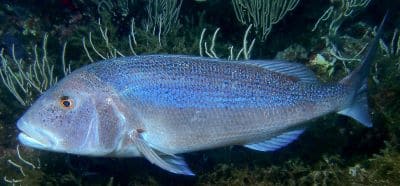Home › Sea Wildlife › Marine › Vertebrates › Sea Breams › Dentex
Interesting Facts about Dentex Fish
[Phylum: Chordata] [Class: Actinopterygii] [Order: Spariformes] [Family: Sparidae (ray-finned)]
Most sea breams have a high commercial value as a food fish. But, the life history of the marine ray-finned dentex fish has endangered the species.
This section contains facts and information about the common dentex (Dentex dentex), including where to find this saltwater predator, what they eat, and why it's classified as Vulnerable.
Habitat and Distribution of Common Dentex
Like most sea bream species (Spariformes), the geographical range of this predatory benthopelagic fish is extensive.
But, the commercial fishing of common dentex focuses on several key regions, including parts of the:
- British Isles (less frequent)
- Mediterranean Sea (North Africa, Spain)
- Northeastern Atlantic Ocean (Madeira, the Canary Islands)
- Western Black Sea
By and large, it's a solitary pelagic groundfish. It spends most of the day hunting for food around rocky outcrops at depths between fifteen and fifty metres. Even so, there have been sightings of the common dentex at 200 metres below the surface (660 feet).
Dentex Sea Bream Characteristics
In fact, the word "dentex" translates to a creature with "large teeth". Put another way, this fish has strong, conical teeth - like canines - with the outer row being the most pronounced and the biggest.
The dorsal fin supports a total of eleven (11) spines, which increase exponentially in length up to the fourth or fifth spine. There are three (3) spines on the anal fin, with no more than nine (9) soft rays supporting it.
Here's the thing:
After reaching adult stage, common dentex fish develop a compressed, oval-shaped body with a smooth, almost rounded, dorsal profile at the head.
 Even though they have small eyes, the space underneath is scaly and wide.
Even though they have small eyes, the space underneath is scaly and wide.
The head points "upward", and the wide mouth is a strong feature positioned at the bottom.
Dentex can grow up to 100 cm (39 inches) and the biggest specimens can weigh up to 14.3 kg (32 pounds).
What Do Common Dentex Fish Eat?
This vigorous, deep-bodied predator feeds on most benthic invertebrates, including clams, crustaceans, mollusks, squid, and worms (e.g. annelids).
Dentex Fish Reproduction
The largest species tend to live a solitary existence when they are not spawning. Even so, juvenile sea breams like to congregate in schools (e.g. shoaling for enhanced protection).
Fully-grown adults gather in small groups for about three weeks during the reproductive process in the springtime, when the water gets warmer.
Studies suggest most common sea breams are gonochoristic, but hermaphroditism exists within the genus. Males and females tend to reach the same size in preparation of mating, reaching sexual maturity between two (2) and four (4) years old.
Threats and Predators
It is true to say that the large-bodied common dentex is vulnerable to overfishing. Yet, populations are increasing in some protected areas of the Mediterranean.
Besides being a popular sport fish for recreational anglers, landings made by bottom trawls and fish traps remain as a genuine threat to its long term survival.
Important: Even though there are some efforts to protect this slow-growing fish, the IUCN Red List of Threatened Species highlights them as being Vulnerable (VU).
Related Information and Help Guides
- A to Z of the Marine Biology Terminology
- Boops Boops Fish Facts and Species Information
- Sea Bream Facts and Information with Pictures
- 10 Examples of Marine Vertebrate Fish Species
Note: The short video [3:13 seconds] presented by 'Abang Aram' contains fun and interesting facts about different species of sea bream.